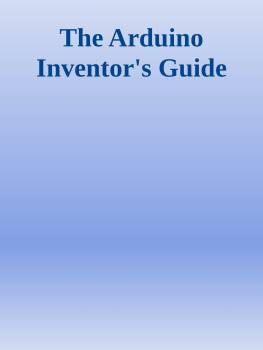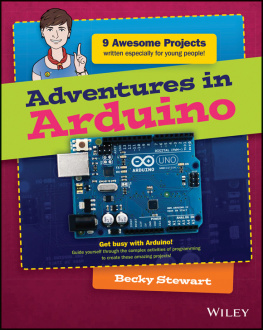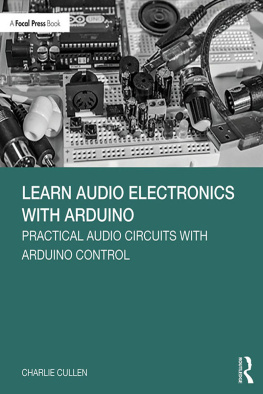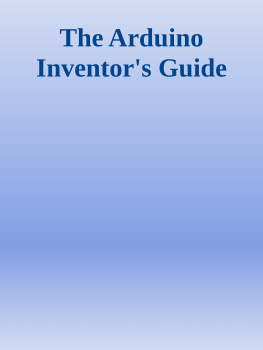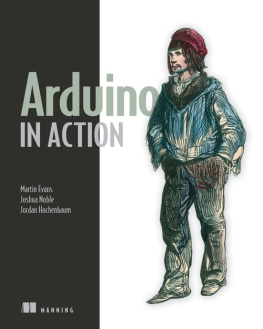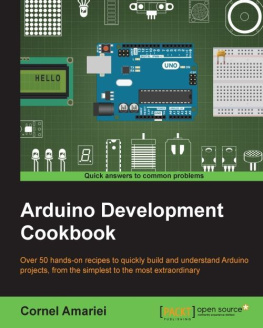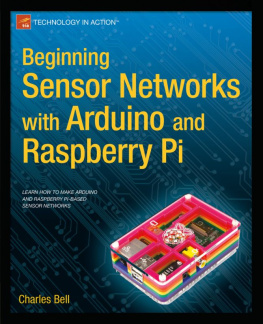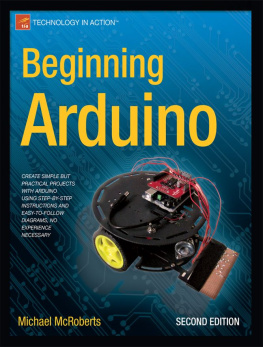THE ARDUINO INDENTORS GUIDE
LEARN ELECTRONICS BY MAKING 10 AWESOME PROJECTS
BRIAN HUANG
DEREK RUNBERG
SAN FRANCISCO
THE ARDUINO INVENTORS GUIDE. Copyright 2017 by SparkFun Electronics.
All rights reserved. No part of this work may be reproduced or transmitted in any form or by any means, electronic or mechanical, including photocopying, recording, or by any information storage or retrieval system, without the prior written permission of the copyright owner and the publisher.
ISBN-10: 1-59327-652-4
ISBN-13: 978-1-59327-652-2
Publisher: William Pollock
Production Editors: Alison Law and Riley Hoffman
Cover Illustration: Brian Cook
Interior Design: Beth Middleworth
Photographer: Juan Pea
Illustrations: Pete Holm
Developmental Editors: Jennifer Griffith-Delgado and Liz Chadwick
Technical Reviewer: Daniel Hienzsch
Copyeditor: Rachel Monaghan
Compositors: Susan Glinert Stevens and Riley Hoffman
Proofreader: Lisa Devoto Farrell
The following image is reproduced with permission: Richard Hall.
Circuit diagrams and schematics were created using Fritzing (http://fritzing.org/).
For information on distribution, translations, or bulk sales, please contact No Starch Press, Inc. directly:
No Starch Press, Inc.
245 8th Street, San Francisco, CA 94103
phone: 1.415.863.9900;
www.nostarch.com
Library of Congress Cataloging-in-Publication Data
Names: Huang, Brian, author. | Runberg, Derek, author.
Title: The Arduino inventor's guide: learn electronics by making 10 awesome
projects / Brian Huang and Derek Runberg.
Description: San Francisco : No Starch Press, Inc., [2017]
Identifiers: LCCN 2017005801 (print) | LCCN 2017023025 (ebook) | ISBN
9781593278397 (epub) | ISBN 159327839X (epub) | ISBN 9781593278403 (mobi)
| ISBN 1593278403 (mobi) | ISBN 9781593276522 (pbk.) | ISBN 1593276524
(pbk.)
Subjects: LCSH: Arduino (Programmable controller) | Electronics--Amateurs'
manuals.
Classification: LCC TJ223.P76 (ebook) | LCC TJ223.P76 R86 2017 (print) | DDC
006.2/2--dc23
LC record available at https://lccn.loc.gov/2017005801
No Starch Press and the No Starch Press logo are registered trademarks of No Starch Press, Inc. Other product and company names mentioned herein may be the trademarks of their respective owners. Rather than use a trademark symbol with every occurrence of a trademarked name, we are using the names only in an editorial fashion and to the benefit of the trademark owner, with no intention of infringement of the trademark.
The information in this book is distributed on an As Is basis, without warranty. While every precaution has been taken in the preparation of this work, neither the authors nor No Starch Press, Inc. shall have any liability to any person or entity with respect to any loss or damage caused or alleged to be caused directly or indirectly by the information contained in it.
TO LINDSAY DIAMOND, FOR YOUR AMAZING LEADERSHIP AND GUIDANCE; TO THE ENTIRE TEAM AT SPARKFUN; AND TO ALL THE FUTURE TINKERERS AND INVENTORS WE INSPIRE!
About Sparkfun Electronics
SparkFun is an online retailer that produces and sells the widgets and parts that end up in a lot of maker projects, prototypes, and even the International Space Station. Nathan Seidle started the company after blowing a circuit board in 2003, while he was an undergraduate at the University of Colorado Boulder. At the time, circuit boards were really hard to get; you had to fax your credit card to another country and hope that you got your hardware in six to eight weeks. Nathan felt he could do better, and he did. SparkFun. com was born, and it now sells over 3,000 different parts of all shapes and sizes for your digital electronic needs. From a basic Arduino to GPS modules, you can find them and all of the documentation you need to get up and running at SparkFun.
SparkFuns Department of Education develops curricula and runs professional development programs for educators of all kinds. The department is at the forefront of a number of computer science and maker initiatives that are making headway in the classroom. You can learn more about SparkFun and the Department of Education at https://www.sparkfun.com/ and http://www.sparkfuneducation.com/.
About the Authors
Brian Huang and Derek Runberg were both teachers at one point. Brian was a high school physics teacher with an affinity for robots, and Derek was a middle school technology teacher obsessed with pushing the limits of middle school students. Theyve taken very different paths to get where they are now, including how they learned programming and electronics, their teaching philosophies, and their viewpoints on how students learn, so they are a bit of an odd couple. They hope that this book will serve you well as you set off on your adventure into the world of inventing.
About the Technical Reviewer
Daniel Hienzsch is the founder of Rheingold Heavy, which delivers educational content and materials to electronics enthusiasts and students. He previously worked in IT for 20 years, including 10 years as the IT director for an investment bank. Dan is passionate about education, and Rheingold Heavy is his effort to provide the maker community with materials he wished he had when he was first getting started in electronics and technology. He is also a certified scuba instructor.
A Note from Brian
Although I am a formally trained engineer (I went to school to study electrical engineering), my education focused a lot on theory, simulations, and modeling, and I was never taught how to solder, machine, or really build things. After graduating from college, I worked as an engineer during the week, and found myself volunteering at the Science Museum of Minnesota on the weekends. It was at the museum where I discovered my love of teaching. I was given the opportunity to inspire children to be curious, ask questions, and wonder about the world. My experiences in the museum set me on a course to change careers, pursue a masters in education, and become a high school physics teacher.
Derek and I complement each others experience and background. This book is a culmination of both of our experiences in teaching and in learning how best to use Arduino in the classroom. As Derek puts it, the Arduino is simply another material that we use in our projects. The faculty and students at NYUs Integrated Telecommunications Program (ITP) have long known this. The way you interact with electronics changes immediately when you enclose or cover them. Even something as simple as using a ping-pong ball to diffuse an LED immediately affects your interaction with the project. The way the light diffuses and blends through materials teases your emotions in a way that you wouldnt get with just an LED in a breadboard.
Weve put a lot of thought into how to make learning electronics and programming accessible for anyone. We hope that these projects will help to unleash your inner inventor!
A Note from Derek
Unlike Brian, I have no formal background in electronics or computer programming; I am completely self-taught. I learned Arduino so that I could give my students access to a technology they could control and build with. I was a middle school technology teacher asked to dream up a shop class for the 21st century. Electronics was part of that vision, and over a three-year process, Arduino (and, later, the Processing language) took center stage in my classroom. I learned electronics and programming so that I could teach it in my class.
Many of these projects come directly from my classroom experience teaching Arduino. My students learned computer science and electronics out of necessity, in order to develop their ideas rather than have a teacher telling them because you need to. I hope that my contribution to this book honors my students and puts electronics and programming into a format that sparks your imagination.

